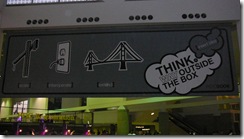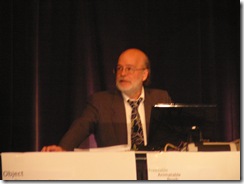My forth day at PDC was dominated by two very interesting sessions regarding RESTful web service design and creating textual domain specific languages with the new "M Grammar" which is part of the "Oslo" project.
RESTful Web Services
REST is a very interesting architectural style to create Web Services based on simple standards like plain HTTP, heavy use of URIs and simple data formats like XML, JSON or ATOM. RESTful services deliberately avoid the more complex WSDL/SOAP world and trust in the power of HTTP. This PDC showed, that Microsoft itself makes heavy use of the REST idea in several areas.
Azure and Live services use REST in combination with the ATOM Pub format in order to hyperlink entities in a uniform and simple way - thus leveraging possibilities for dynamic service clients.
The PDC session "WCF: Developing RESTful Services" by Steve Maine and his colleague Ron was one of the highlights at this PDC, because both speakers made a great job to outline the basic REST ideas and motivate the use of this approach in combination with WCF. WCF itself supports REST with its WebHttpBinding since version 3.0. But the WCF team has just released an add-on package during PDC in order to further simplify the creation of solid RESTful services with WCF. The speakers showed some great demos on how to
- use attributes in order to route HTTP verbs to the correct method
- use newly created exception types to report correct HTTP status codes in a very .NET-friendly way
- create services that easily expose and clients that consume your data via JSON (for AJAX clients) or ATOM pub for smart clients
- how to use tools like Fiddler to inspect REST conversations
- how WCF offers metadata for RESTful services via ATOM Pub
You should be able to find the add-on package in the meantime via http://msdn.microsoft.com/wcf/rest. I would also strongly recommend to watch the video of this great session, if you are interested in this topic.
"Oslo": Building textual DSLs
Chris Anderson and Giovanni Della-Libera gave a demo-focussed talk about "M Grammar" and its use to create your own textual DSL. They showed, what it takes to create a flexible textual DSL for telephone contacts like the following line:
contact: John Doe 2334-2345-222
The demo showed how to build up tokens, syntax trees, white-space handling, recursions etc. Chris and Giovanni revealed the real power of the "M Grammar" with several samples and created their contact language in an incremental fashion. Currently the usage of the DSL still seems in a very early stage - features like LINQ and dynamic types will need to be implemented before a final release.
The audience was very interested - many language gurus had deep questions regarding details of the new language and gave Microsoft lots of interesting ideas for the next months and years.
I'm very curios, where this journey will lead the development on the .NET platform - in my opinion it might have a big impact in how we develop in the future.
Summary
In my opinion "Oslo" was _the_ technical innovation at this PDC. I think the language and its tools will undergo heavy refactorings during the next 12 months - but it will be a big leap into the right direction.
Windows Azure and its services will help fast growing companies to host their environment and to avoid heavy investments in on-premise hardware. Azure and its Internet Service Bus are also a great opportunity to build supply-chain solutions or connect enterprises in a very elegant fashion - without sacrificing security investments - Azure just federates between the custom already-established security systems. Azure also allows event-driven and pub-sub architectures between enterprises behind firewalls - which was hard to establish before without opening security holes.
Windows 7 is again a new Windows OS - and doesn't seem to be a BIG release from the perspective of a software engineer. But it will improve certain common problems like working in different networks etc. It will find its customers and make fewer problems than Vista, because the Vista device driver model isn't changed and Microsoft seems to have learnt some of the Vista lessons...
VSTS 2010 and .NET 4.0 will be very big releases. Microsoft pushes heavily in many different areas. WF is strongly improved and is used in many other products. The C# compiler will be heavily improved in v4. WPF and Silverlight merge stronger together and learn from each other. XAML is further improved and designed to be a solid basis for vast parts of the platform.
Last but not least: Microsoft apparently watches developments in the community and reacts quite fast (regarding the size of the company) to new trends like dynamic languages, REST and cloud or parallel computing - without sacrificing investments of the past. This makes the .NET platform a solid basis for application and service development, which will reach even higher maturity with v4.

